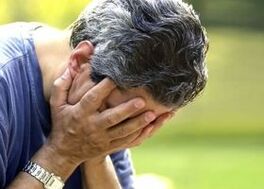
Men, like women, have fears. Women are afraid of losing their beauty and becoming unattractive, and men are afraid of feeling male failure. When a man is diagnosed with prostatitis, he immediately feels panic and fear of losing his male strength, sometimes it is useful for a man to see a psychologist with a urologist.
Prostatitis is an inflammatory disease of the prostate gland (prostate). Similar in shape and size to a chestnut, this organ is located just below the bladder and produces semen, which is involved in the transfer of sperm. But the whole problem is that the same organ (the urethra) performs both functions, both as a urethra and as a conductor of semen. As the prostate becomes inflamed, both functions begin to be affected, which is the complexity of the development and treatment of prostatitis. For women, everything is much simpler in this regard because the functions are separate for them.
signs of prostatitis
The National Institutes of Health divides prostatitis into four categories:
- acute bacterial prostatitis
- chronic prostatitis
- nonbacterial prostatitis
- asymptomatic prostatitis
Symptoms and signs of prostatitis vary by category.
Acute bacterial prostatitis is acute and has the following symptoms:
- flu-like symptoms
- chills and fever
- Groin, lower back, and prostate pain
- frequent urination
- Pain when urinating and blood in the urine
- Pain during ejaculation
At these signs, you should call an ambulance or seek medical attention immediately.
Chronic bacterial prostatitis does not develop as rapidly as the first type of prostatitis. Symptoms develop more slowly, the course of the disease occurs in waves, that is, periods of calm are replaced by exacerbations.
Symptoms of chronic prostatitis:
- burning and pain when urinating
- frequent urination, especially at night
- Pelvic, lower back, and genital pain
- recurrent cystitis
The symptoms of chronic nonbacterial prostatitis are very similar to bacterial prostatitis, but in most cases, it is free of fever and exacerbations. Bacterial prostatitis can only be distinguished from nonbacterial prostatitis by special laboratory tests.
Symptoms and signs of prostatitis are similar to many other diseases.
Causes of Prostatitis
The main cause of prostatitis is a type of bacteria found in the large intestine. The infection begins to develop directly in the prostate, but sometimes it also enters the prostate from the bladder or urethra. Chronic bacterial prostatitis can develop after acute prostatitis, or it can arise due to infection of other organs that may be the source of infection.
The etiology of chronic nonbacterial prostatitis is not fully understood, and several reasons and theories have been proposed for the occurrence of the disease:
- Lifting heavy objects can cause disease. If you lift heavy objects with a full bladder, urine will enter the prostate, causing inflammation;
- Spasms of the pelvic muscles or anatomical disturbances of the urogenital tract can also lead to inflammation;
- Interstitial cystitis, although it is primarily a women's disease, it can also occur in men;
These are the main symptoms, signs and causes of prostatitis. Prostatitis is not a contact disease, nor is it sexually transmitted.
How to cure prostatitis
Treatment in this condition can only be prescribed by a doctor after a diagnosis has been made. Don't listen to the advice of friends who are willing to try to cure them. Medications for prostatitis are prescribed separately. For Type 1 and Type 2 prostatitis, antibiotics, physical therapy, bathing and massage. Sometimes, although in rare cases, surgery may be required.
In order to keep prostatitis out of your life, you need the right and healthy lifestyle, as well as regular sex (don't forget the means of protection and protection). Coffee, cigarettes and spicy food should be avoided as much as possible. Also, you need to drink plenty of water and don't forget to empty your bladder regularly and on time. Any disease is easier to prevent than to treat.





























